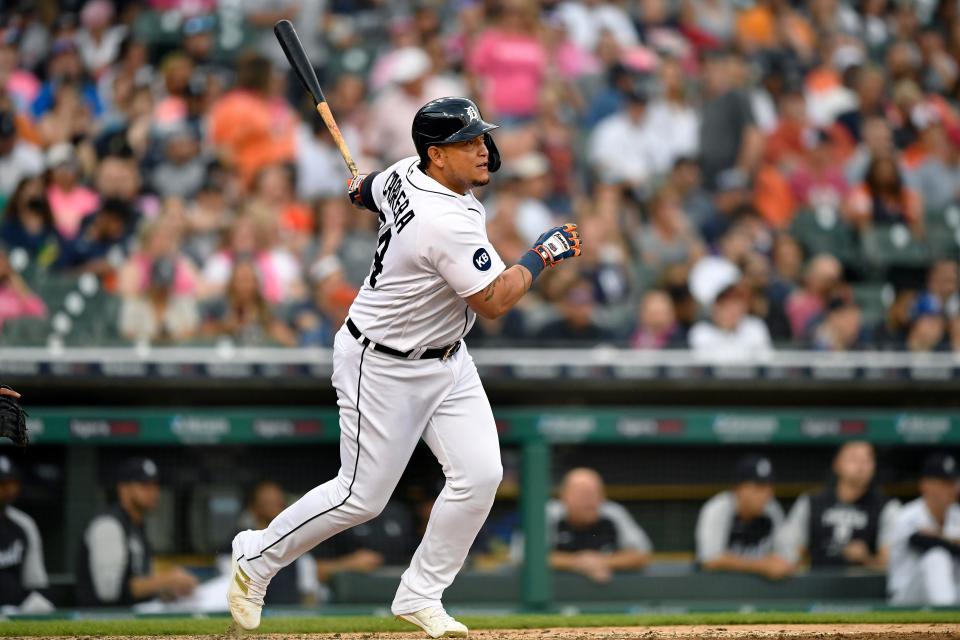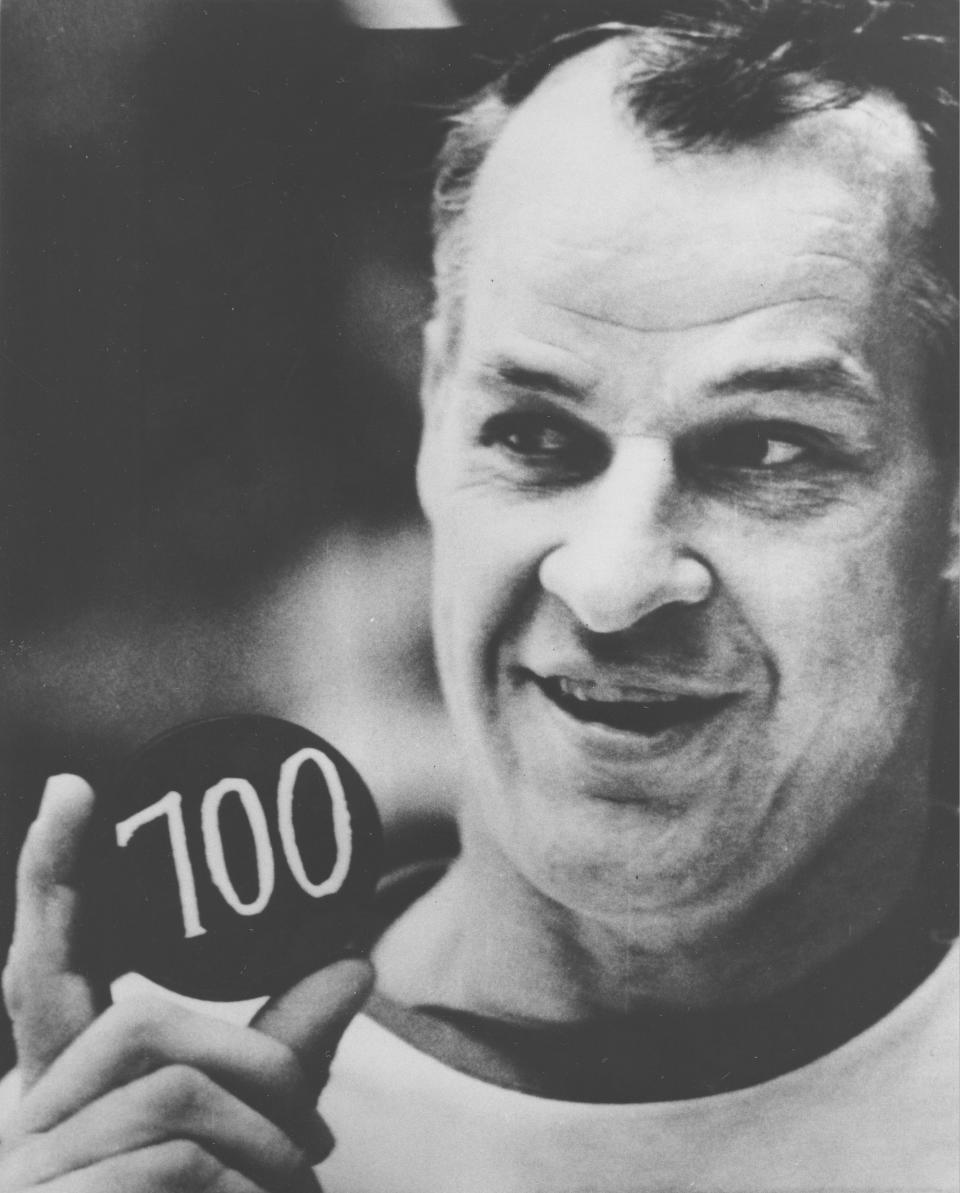Miguel Cabrera slugging at 39; here's how his 2022 compares with greats in other sports
With his 0-for-4 performance against the Toronto Blue Jays on Saturday, Detroit Tigers designated hitter Miguel Cabrera dropped his batting average this season to .291.
Cabrera has been flirting with hitting .300 all season — his average topped out at .326 on April 23, as he picked up career hit No. 3,000, then fell as low as .247 a couple weeks later — as he chases a milestone for the ages … or, more accurately, one for the aged.

Though there’s nearly two-thirds of the season remaining, Cabrera has a shot at becoming just the 16th player to top .300 in his age-39 season while qualifying for the batting title. It’s a rare enough feat that no Tiger has done it — not even Ty Cobb. (Although Cobb hit .339 at age 39 in 1926, his final year with the Tigers, it was in only 79 games, well short of the 100 games then needed to qualify. The highest batting average by a Tiger who qualified for the title in his age-39 season belongs to Doc Cramer, who hit .275 in 1945.)
SLIGHTLY YOUNGER: Ty Madden keeps on giving at High-A West Michigan
SATURDAY'S GAME: Beau Brieske stymies Jays' offense as Tigers top Toronto, 3-1
But as good a season as Cabrera is having in 2022, it pales in comparison to some other 39-year-olds all-time in the four major pro leagues. Let’s take a look at the best age-39 seasons of all time:
MLB: Barry Bonds, 2004 Giants
Even in an era of ridiculous offensive numbers — baseball as a whole hit .266/.335/.428 that season, compared to .240/.311/.388 this season — and performance-enhancing drugs, Bonds’ numbers are just goofy: a .362 average, 45 home runs, 232 walks and just 41 strikeouts in 617 plate appearances. How much was he feared? Bonds was intentionally walked 120 times, while only three other players (Bobby Abreu, Lance Berkman and Todd Helton) that season walked at least 120 times, intentional or not. Bonds reached base 60.9% of his plate appearances, and when he swung the bat, posted an .812 slugging percentage that was 155 points higher than No. 2 in the majors (Albert Pujols, at .657).
Honorable mentions: It’s tempting to go with Ted Williams’ 1958, in which he had a .328/.458/.584 slash line for the Red Sox, but we should also highlight the men on the mound — Dazzy Vance led the NL with a 2.61 ERA over 258⅔ innings in 1930. He only made 31 starts — low in the days of four-man rotations — but 21 of them resulted in complete games (fourth in the NL), and his four shutouts led the majors.
NBA: Karl Malone, 2002-03 Jazz
The Mailman’s final season in Utah — he attempted to win a title the following season with the Lakers, only to be shut down by the Pistons in the NBA Finals — certainly delivered. Malone averaged 20.6 points, 7.8 rebounds and 4.7 assists in 36.2 minutes per game, plus 1.7 steals. Each of those averages led the Jazz, other than the assists. (Malone finished second behind his pick-and-roll pal John Stockton, who averaged 7.7 assists in his final season, at age 40.) Malone’s rebounds were just over half the league leader — Detroit’s Ben Wallace, at 15.4 — but still good for 20th, while his scoring average ranked 22nd.
Honorable mention: It’s practically mandated under sports writing law that a Malone mention must come with a Stockton follow, so we’ll give the nod at No. 2 to the Gonzaga alumnus who lit it up in 2001-02, his next-to-last season. Stockton’s 13.4 points per game were his best since the 1996-97 season, and he also averaged 8.2 assists, 3.2 rebounds, 1.9 steals and 31.3 minutes per game. It wasn’t enough to get the Jazz out of the first round of the playoffs, but Stockton was one of 17 players to receive an All-NBA first-team vote.
A PISTONS GREAT TALKS: How Grant Hill almost came back for a second stint
NFL: Drew Brees, 2018 Saints
It wasn’t quite a vintage season for the Purdue product — his 3.992 yards passing were his fewest since 2005, his final season with the San Diego Chargers. But nearly everything else was stellar, as Brees led the NFL with a 115.7 passer rating while completing 74.4% of his passes, with 32 touchdowns and five interceptions. The Saints went 13-2 in his starts, and Brees, who made the Pro Bowl, finished second in MVP and Offensive Player of the Year voting, behind 23-year-old Patrick Mahomes.
Honorable mention: On the defensive side, we turn to Charles Woodson, who went out on top with the Oakland Raiders in 2015, his final season. The Michigan cornerback (and Heisman Trophy winner) turned safety had 74 tackles and five interceptions (sixth most in the NFL) en route to the ninth Pro Bowl nod of his career. Not only was Woodson a standout among 2015 defenders, he had a season for all-time: those five picks were two more than any other 39-year-old defender in NFL history (ahead of Washington’s Darrell Green, who had three in 1999).
DAVE BIRKETT'S MAILBAG: Here's a couple reasons to have hope this season

NHL: Gordie Howe, 1967-68 Red Wings
C’mon, you knew Mr. Hockey was going to make this list. Howe scored 39 goals in 1967-68, finishing third in the league behind only Chicago’s Bobby Hull and Stan Mikita, nine and 10 years his juniors, respectively. Even more impressive, 29 of those goals came at even strength, the second-best total in the league. He also had 43 assists to finish eighth in the NHL, and 82 points, third-best. He made the All-NHL first team, and finished fifth in MVP voting, despite the Wings sinking to last in the East Division, with the second-worst record in the newly expanded league. Not too bad, considering he turned 40 on the last day of the Wings’ season.
Honorable mention: Despite NHL careers lasting longer than ever — we see you, Joe Thornton — our runner-up also starred in the 1960s. Maple Leafs goaltender Johnny Bower carried Toronto to the Stanley Cup (when’s the last time you heard that phrase) with an NHL-best .932 save percentage and 2.11 goals-against average over 51 appearances. He saved his best for the postseason, however; Bower allowed just four goals in the four games in which the Leafs faced elimination — including a shutout in Game 7 of the Stanley Cup Final against the Red Wings. (Howe was, unfortunately for the Wings, a minus-3 at age 36.)
Contact Ryan Ford at rford@freepress.com. Follow him on Twitter @theford. Read more on the Detroit Tigers and sign up for our Tigers newsletter.
This article originally appeared on Detroit Free Press: Detroit Tigers' Miguel Cabrera: Still producing late in career

